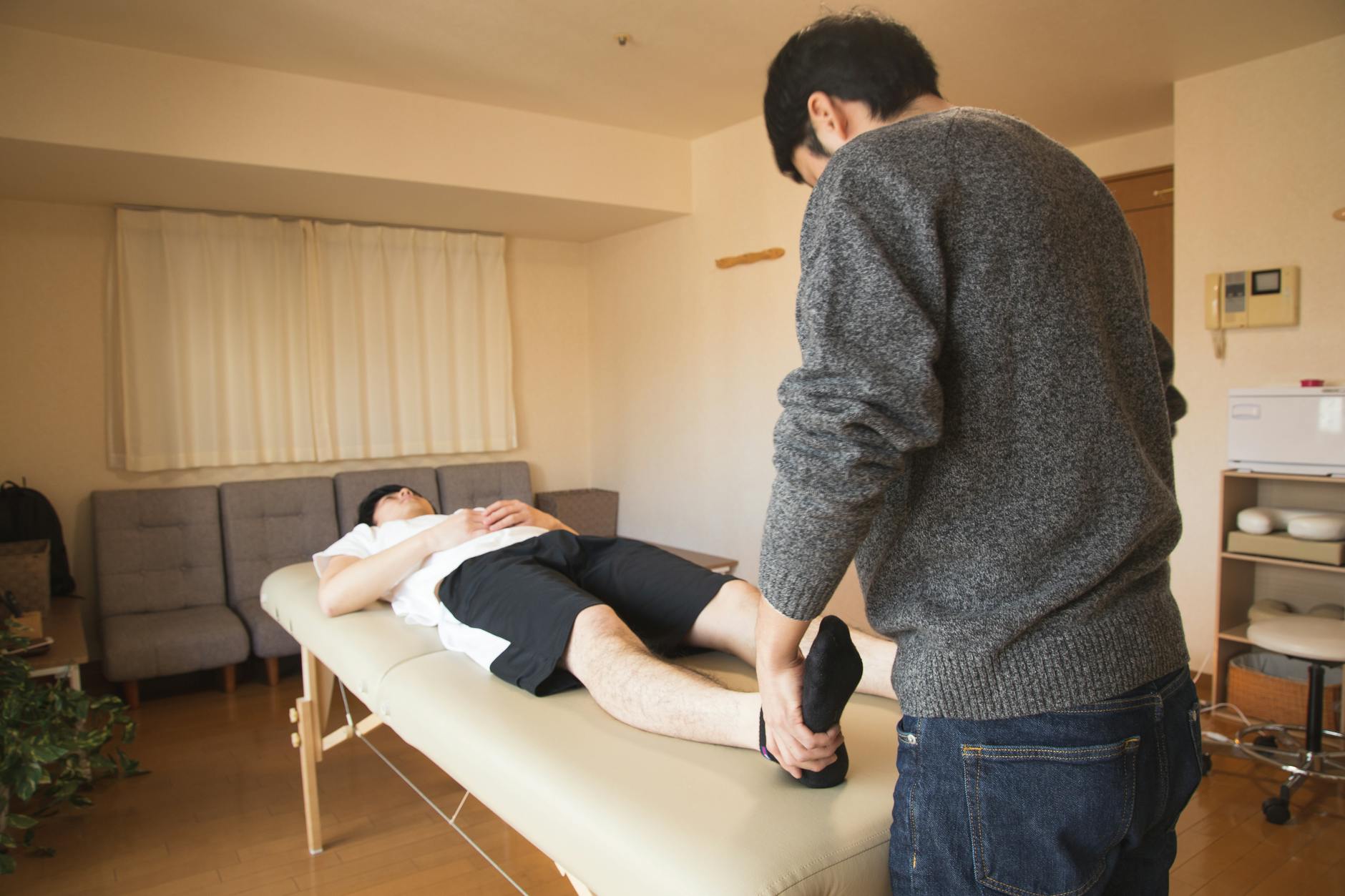Physiotherapy day

 You’re not alone. Millions of people worldwide grapple with physical discomfort, limited mobility, and chronic pain. But here’s the good news: there’s a group of unsung heroes working tirelessly to get you back in top form – physiotherapists.
You’re not alone. Millions of people worldwide grapple with physical discomfort, limited mobility, and chronic pain. But here’s the good news: there’s a group of unsung heroes working tirelessly to get you back in top form – physiotherapists.As we celebrate World Physiotherapy Day, it’s time to shine a spotlight on these movement maestros and their invaluable contribution to our health and well-being. From helping athletes bounce back from injuries to assisting the elderly in maintaining their independence, physiotherapists play a crucial role in our lives. But what exactly do they do, and how can their expertise benefit you?
Join us as we dive into the world of physiotherapy, exploring its key practices, cutting-edge techniques, and the exciting future that lies ahead. Whether you’re a fitness enthusiast, a curious student, or someone simply looking to improve their quality of life, this journey through the realm of physiotherapy promises to be both enlightening and empowering. Let’s unlock the secrets to a healthier, more mobile you!

Understanding Physiotherapy
A. Definition and scope of physiotherapy
Physiotherapy, also known as physical therapy, is a healthcare profession focused on restoring and maintaining physical function, mobility, and overall well-being. It encompasses a wide range of interventions designed to improve quality of life for individuals affected by injury, illness, or disability.
The scope of physiotherapy extends across various domains:
Musculoskeletal conditions
Neurological disorders
Cardiovascular and respiratory issues
Pediatric and geriatric care
Sports injuries and performance enhancement
B. Importance in healthcare
Physiotherapy plays a crucial role in the healthcare system, offering numerous benefits:
| Benefits | Description |
|---|---|
| Pain management | Reduces reliance on medication |
| Injury prevention | Teaches proper body mechanics |
| Rehabilitation | Speeds up recovery post-surgery or injury |
| Chronic disease management | Improves quality of life for long-term conditions |
| Enhanced mobility | Promotes independence in daily activities |
As a non-invasive approach, physiotherapy often serves as a first-line treatment or complementary therapy to other medical interventions.
C. Brief history of physiotherapy
The roots of physiotherapy can be traced back to ancient civilizations, but its modern form emerged in the late 19th and early 20th centuries:
1894: The Chartered Society of Physiotherapy was founded in England
World War I: Physiotherapy gained prominence in rehabilitating injured soldiers
1921: The American Physical Therapy Association was established
Post-World War II: Rapid advancement in techniques and technology
Present day: Integration of evidence-based practice and cutting-edge technology
Today, physiotherapy continues to evolve, adapting to new challenges and incorporating innovative approaches to patient care. With this foundation, let’s explore how World Physiotherapy Day celebrates the profession’s contributions to global health.

Celebrating World Physiotherapy Day
World Physiotherapy Day is an annual global event that highlights the crucial role physiotherapists play in healthcare. This celebration brings together professionals, patients, and communities worldwide to recognize the importance of physiotherapy in improving quality of life.
Global events and activities
World Physiotherapy Day is marked by a variety of events and activities across the globe:
Educational seminars
Free health screenings
Fitness workshops
Community outreach programs
Social media campaigns
These events aim to raise awareness about the benefits of physiotherapy and promote overall health and well-being.
| Event Type | Purpose | Target Audience |
|---|---|---|
| Seminars | Education | Healthcare professionals |
| Screenings | Prevention | General public |
| Workshops | Engagement | Patients and caregivers |
| Outreach | Awareness | Local communities |
Theme for this year
Each year, World Physiotherapy Day focuses on a specific theme to address current health challenges and priorities. The theme serves as a guiding principle for events and discussions, highlighting particular aspects of physiotherapy practice or global health concerns.
Date and origin
World Physiotherapy Day is celebrated annually on September 8th. This date was chosen to commemorate the founding of the World Confederation for Physical Therapy (WCPT) in 1951. The day has been observed since 1996, making it a longstanding tradition in the physiotherapy community.
As we explore the significance of this global celebration, it’s important to understand the key areas where physiotherapists make a difference in people’s lives.

Key Areas of Physiotherapy Practice
Physiotherapy is a diverse field that encompasses various specialized areas to address different patient needs. Let’s explore the key areas of physiotherapy practice:
A. Geriatric Physiotherapy
Geriatric physiotherapy focuses on the unique needs of older adults. It aims to:
Improve mobility and balance
Reduce fall risks
Manage age-related conditions like arthritis and osteoporosis
B. Pediatric Physiotherapy
This specialization deals with infants, children, and adolescents. Pediatric physiotherapists work on:
Developmental delays
Congenital disorders
Injuries specific to growing bodies
C. Cardiorespiratory Physiotherapy
Cardiorespiratory physiotherapy targets the heart and lungs. It helps patients with:
Chronic obstructive pulmonary disease (COPD)
Asthma
Cardiac rehabilitation after heart surgery
D. Neurological Rehabilitation
This area focuses on patients with neurological disorders or injuries. It involves:
Stroke rehabilitation
Treatment for spinal cord injuries
Management of conditions like Parkinson’s disease
E. Musculoskeletal Therapy
Musculoskeletal therapy is one of the most common areas of physiotherapy. It deals with:
Sports injuries
Back and neck pain
Joint problems and arthritis
Here’s a comparison of these key areas:
| Area | Primary Focus | Common Conditions Treated |
|---|---|---|
| Geriatric | Aging-related issues | Arthritis, osteoporosis, balance disorders |
| Pediatric | Developmental issues | Cerebral palsy, muscular dystrophy, sports injuries |
| Cardiorespiratory | Heart and lung function | COPD, asthma, post-cardiac surgery rehabilitation |
| Neurological | Nervous system disorders | Stroke, spinal cord injuries, multiple sclerosis |
| Musculoskeletal | Muscles, bones, and joints | Sports injuries, back pain, arthritis |
Each of these areas requires specialized knowledge and techniques, highlighting the diverse nature of physiotherapy practice. Next, we’ll explore the numerous benefits that physiotherapy can offer to patients across these different areas of practice.

Benefits of Physiotherapy
Physiotherapy offers a wide range of benefits that can significantly improve a person’s quality of life. Let’s explore some of the key advantages:
A. Enhanced athletic performance
Physiotherapy plays a crucial role in helping athletes reach their peak performance. By focusing on:
Strength and conditioning
Flexibility and mobility
Sport-specific training
Athletes can experience:
Improved power and endurance
Faster recovery times
Reduced risk of injuries
B. Prevention of injuries
One of the most valuable aspects of physiotherapy is its ability to prevent injuries before they occur. This is achieved through:
Biomechanical assessments
Personalized exercise programs
Education on proper body mechanics
| Prevention Strategy | Benefits |
|---|---|
| Postural correction | Reduces strain on muscles and joints |
| Core strengthening | Improves stability and balance |
| Flexibility training | Enhances range of motion |
C. Improved mobility and function
Physiotherapy can significantly enhance mobility and function, particularly for those recovering from injuries or managing chronic conditions. This is accomplished through:
Targeted exercises
Manual therapy techniques
Assistive device training
These interventions can lead to:
Increased independence in daily activities
Better joint function
Enhanced overall quality of life
D. Pain management
Effective pain management is a cornerstone of physiotherapy. Therapists use a variety of techniques to alleviate pain, including:
Manual therapy
Electrotherapy
Heat and cold therapy
By addressing the root cause of pain and providing strategies for long-term management, physiotherapy can help individuals:
Reduce reliance on pain medications
Improve sleep quality
Increase participation in social and recreational activities
With these diverse benefits, physiotherapy proves to be an invaluable tool in promoting overall health and well-being. Next, we’ll explore the various techniques and tools used by physiotherapists to achieve these remarkable outcomes.

Now that we’ve explored the benefits of physiotherapy, let’s delve into the various techniques and tools used by physiotherapists to help patients recover and improve their quality of life.
A. Hydrotherapy
Hydrotherapy, also known as aquatic therapy, utilizes the properties of water to facilitate healing and rehabilitation. This technique is particularly beneficial for:
Patients with joint pain or arthritis
Those recovering from injuries or surgeries
Individuals with balance or mobility issues
| Benefits of Hydrotherapy | Description |
|---|---|
| Reduced joint stress | Water buoyancy decreases weight-bearing on joints |
| Improved circulation | Hydrostatic pressure aids blood flow |
| Enhanced flexibility | Warm water relaxes muscles and increases range of motion |
B. Electrotherapy
Electrotherapy involves the use of electrical stimulation to treat various conditions. Common electrotherapy techniques include:
Transcutaneous Electrical Nerve Stimulation (TENS)
Interferential Therapy (IFT)
Ultrasound therapy
These methods can help with pain management, muscle re-education, and tissue healing.
C. Exercise Prescription
Tailored exercise programs are a cornerstone of physiotherapy. Physiotherapists design specific exercises to:
Improve strength and flexibility
Enhance balance and coordination
Increase cardiovascular endurance
Prevent future injuries
Exercise prescription may include a combination of stretching, resistance training, and aerobic activities, customized to each patient’s needs and goals.
D. Manual Therapy
Manual therapy involves hands-on techniques performed by physiotherapists to manipulate and mobilize joints and soft tissues. This approach includes:
Joint mobilization and manipulation
Soft tissue massage
Myofascial release
Stretching techniques
Manual therapy can help improve joint mobility, reduce pain, and promote tissue healing.
As we move forward, we’ll explore the path to becoming a physiotherapist and the education required to master these techniques and tools.

Embarking on a career in physiotherapy is both challenging and rewarding. This field offers diverse opportunities for those passionate about helping others improve their physical well-being and quality of life.
Educational Requirements
To become a physiotherapist, one must typically complete:
A bachelor’s degree in a related field (e.g., Biology, Kinesiology)
A Doctor of Physical Therapy (DPT) program
Clinical internships or residencies
| Degree Level | Duration | Focus |
|---|---|---|
| Bachelor’s | 4 years | Foundation in sciences and health |
| DPT | 3 years | Specialized physiotherapy knowledge and skills |
| Residency | 1-3 years | Advanced clinical practice |
Licensing and Certification
After completing educational requirements, aspiring physiotherapists must:
Pass the National Physical Therapy Examination (NPTE)
Obtain state licensure
Consider specialty certifications for advanced practice areas
Career Opportunities
Physiotherapists can work in various settings, including:
Hospitals
Private clinics
Sports teams
Rehabilitation centers
Schools
Home health agencies
Ongoing Professional Development
To maintain licensure and stay current in the field, physiotherapists must engage in continuous learning through:
Continuing education courses
Attending conferences and workshops
Participating in research studies
Joining professional associations
With a solid foundation in education, licensing, and a commitment to ongoing development, physiotherapists can build fulfilling careers helping patients achieve optimal physical function and well-being. As we explore the next section, we’ll see how technology is shaping the future of physiotherapy practice.

As technology continues to advance, the field of physiotherapy is evolving to incorporate innovative digital solutions. These advancements are revolutionizing patient care, treatment approaches, and overall rehabilitation experiences.
AI and robotics in physiotherapy
Artificial Intelligence (AI) and robotics are transforming physiotherapy practices, offering new possibilities for precise diagnosis and personalized treatment plans. AI-powered systems can analyze patient data and movement patterns to provide tailored exercise recommendations, while robotic devices assist in delivering consistent and targeted therapy.
| AI/Robotics Application | Benefits |
|---|---|
| Motion analysis systems | Accurate assessment of movement patterns |
| Exoskeletons | Enhanced mobility and strength training |
| Virtual reality simulations | Engaging and immersive rehabilitation exercises |
Wearable technology in rehabilitation
Wearable devices are becoming increasingly popular in physiotherapy, allowing for continuous monitoring and real-time feedback. These technologies enable therapists to track patient progress remotely and make data-driven decisions about treatment plans.
Smart clothing with embedded sensors
Activity trackers for step counting and posture monitoring
Biofeedback devices for muscle activation and relaxation
Telehealth services
The rise of telehealth has made physiotherapy more accessible than ever before. Remote consultations and virtual therapy sessions allow patients to receive care from the comfort of their homes, breaking down geographical barriers and improving continuity of care.
Video consultations for initial assessments and follow-ups
Mobile apps for guided home exercise programs
Remote monitoring of patient progress through connected devices
As we look towards the future of physiotherapy, these digital innovations are set to play an increasingly important role in enhancing patient outcomes and expanding the reach of physiotherapy services.

Future of Physiotherapy
The field of physiotherapy is rapidly evolving, with exciting developments on the horizon that promise to revolutionize patient care and treatment outcomes.
A. Potential breakthroughs in treatment methods
Advancements in technology are paving the way for innovative treatment methods in physiotherapy:
Virtual Reality (VR) Therapy
Robotic-assisted rehabilitation
AI-powered personalized treatment plans
Wearable technology for real-time monitoring
These breakthroughs have the potential to enhance patient engagement, improve recovery times, and provide more accurate assessments.
B. Challenges facing the profession
Despite the promising future, physiotherapists must navigate several challenges:
| Challenge | Impact |
|---|---|
| Increasing patient demand | Strain on resources and longer wait times |
| Evolving healthcare policies | Adapting to new regulations and reimbursement models |
| Integration of new technologies | Need for continuous learning and skill development |
| Rising healthcare costs | Pressure to demonstrate cost-effectiveness of treatments |
Addressing these challenges will be crucial for the profession’s growth and sustainability.
C. Emerging trends
Several trends are shaping the future of physiotherapy:
Telehealth and remote consultations
Interdisciplinary collaboration with other healthcare professionals
Focus on preventive care and wellness programs
Increased emphasis on evidence-based practice
Integration of holistic approaches, such as mindfulness and nutrition
These trends reflect a shift towards more accessible, comprehensive, and patient-centered care.
As we look to the future, it’s clear that physiotherapy will continue to play a vital role in healthcare, adapting to new technologies and approaches while maintaining its core focus on improving patients’ quality of life through movement and exercise.

Physiotherapy plays a vital role in improving quality of life, promoting physical health, and supporting recovery from injuries and illnesses. From understanding its core principles to exploring various practice areas and cutting-edge techniques, the field of physiotherapy continues to evolve and adapt to meet the changing needs of patients worldwide.
As we celebrate World Physiotherapy Day, it’s essential to recognize the dedication and expertise of physiotherapists who work tirelessly to help individuals regain mobility, manage pain, and achieve optimal physical function. Whether you’re considering a career in physiotherapy or seeking treatment, remember that this dynamic field offers numerous benefits and opportunities for growth. Embrace the power of physiotherapy to enhance your well-being and contribute to a healthier, more active society.


Integer nec odio. Praesent libero. Sed cursus ante dapibus diam. Sed nisi. Nulla quis sem at nibh elementum imperdiet. Duis sagittis ipsum.